Andrei Tarkovsky
HTTP://PRESS.UCHICAGO.EDU/UCP/BOOKS/BOOK/DISTRIBUTED/A/BO5666845.HTML
ELEMENTS OF CINEMA
Existence is Song: The Dream-like Aesthetics of Duration in Mirror
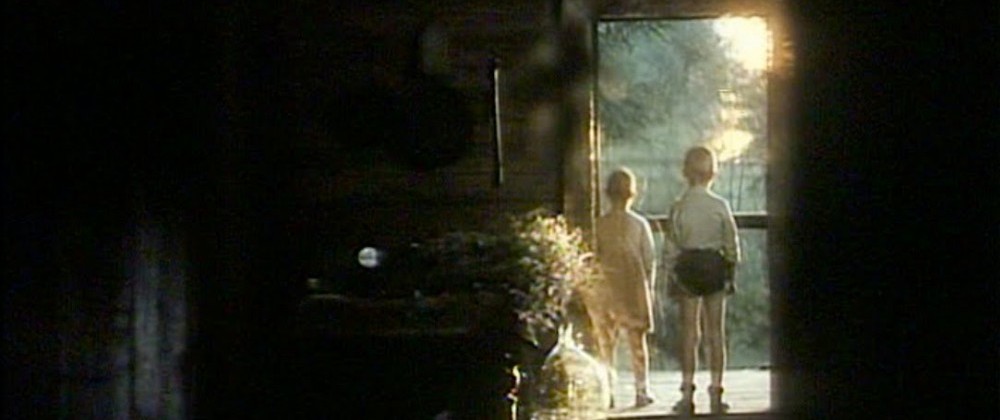 There has been an inseparable connection between film theory and film-making in the history of Soviet cinema, with a shared objective driving them both. Filtering down through Eisenstein and Kuleshov, the essence of cinema has become the holy grail for the Soviet film theorist, and Andrei Tarkovsky’s meditations on the art form prove to be no exception. But as far Tarkovsky’s philosophical grounding of the medium reflects his Soviet heritage, a single viewing of any one of his films would be sufficient to see that Tarkovsky’s films are vastly different from those of Eisenstein or Pudovkin. For the earlier theorists, the distilled essence of cinema lay in montage, but for Tarkovsky this is not so. In his book, Sculpting in Time, Tarkovsky refutes his predecessors’ predilection for editing as presupposing the most basic ontological element of cinema: its ability to capture existence, and therefore time. The time which captivates and precedes Tarkovsky’s aesthetics is not the physical, linear time which can be recorded by a watch, or contained within any mechanism of measurement. This time is spatialized and abstract, and hence a creation of the human intellect. Tarkovsky’s temporality is instead durational, in the same manner as time conceived by Henri Bergson, innate to the human spirit, and his film form follows in likeness. This parallel between film theory and form emerges prominently in his most personal film, Mirror (1975), wherein Tarkovsky achieves a dream-like aesthetic through an adherence to his theory of time both in the narrative and aesthetic composition of the film.
In an effort to penetrate Tarkovsky’s use of time as the ontological centre of cinema, it is necessary to understand that, for him, time is first and foremost a precondition for the human spirit. Consciousness is bound to the corporeal, and thus to physical time, but consciousness also realizes itself through memory, which is a consequence of time in the knowing mind. This introduces a new dimension of temporality distinct from the abstract condition of what can be measured, and it can only be quantified by the progression of objects in space. However, even this form of spatial time depends upon the existence of a real time, one which exists inseparably within the psyche. Without the ability to remember, the evolution of objects in space would become impenetrable by the human mind, and there would be no change recorded because there would be no detectable flux: our minds would register only one static state without extension either into the past or present. Tarkovsky refers to such a person as “the prisoner of an illusory existence; falling out of time he is unable to seize his own link with the outside world – in other words he is doomed to madness” (Tarkovsky 57-58). But time does not behave as such in the human consciousness; it is imprinted onto our memories and is thus realized in the soul. Therefore time and memory are interrelated concepts “like the two sides of a medal” (Tarkovsky 57).
The impossibility of memory-less existence is prevalent in Bergson’s writings as well. He divides consciousness into three mental processes: “pure memory, memory-image, and perception,” and perception, the immediate encounter with external reality, “is never a mere contact of the mind with the object present; it is impregnated with memory-images which complete it” (Bergson 170). Speaking of the present moment in distinction from its other two counterparts, Bergson defines it as “in its essence, sensori-motor” (177), but that is to presume that perception exists independently of its memory processes, which is an impossibility for the philosopher. Rather, time and memory are indivisible from one another, just as in Tarkovsky’s perception of temporality. For Bergson, “the whole of our past psychical life conditions our present state” (191), wherein our recollections are constantly present and contiguous to the influx of stimulus, is swept into the past and participates as memory. In essence, pure perception constitutes very little of our consciousness, as the present moment transpires in a flash and recedes into memory, where it exists more prominently and for a longer moment. Understanding this, we can appreciate the roots of Tarkovsky’s statement that “the present slips and vanishes like sand between the fingers, acquiring material weight only in its recollection” (58).
In Mirror a fundamental example of the gravity of memory can be found in the stock footage of the Soviets crossing Lake Sivash (56:34 – 1:00:07). This sequence is inarguably not a literal memory of the narrator, whom we know was only a child when this death march occurred, and it is also not an assured dream, because it is actual documented footage that Tarkovsky found and did not film himself (Totaro 24). Because the images are historic, they naturally find themselves within the scope of time, yet Tarkovsky states very blatantly that “History is still not Time” (57). The sequence finds itself in a pre-existing state of time native to the narrator, but remains ontologically vague. In a very factual sense, this footage is a highly detailed memory of a past perception, but it is assembled and edited together by an outside source in accord with his own inner experience of it. The footage itself does not reveal the tragedy which it describes unless it is perceived by an audience already familiar with the disastrous event, in which case such a spectator would be bringing their own memories of the scene to flesh out the sensory-motor stimulus presented.
There has been an inseparable connection between film theory and film-making in the history of Soviet cinema, with a shared objective driving them both. Filtering down through Eisenstein and Kuleshov, the essence of cinema has become the holy grail for the Soviet film theorist, and Andrei Tarkovsky’s meditations on the art form prove to be no exception. But as far Tarkovsky’s philosophical grounding of the medium reflects his Soviet heritage, a single viewing of any one of his films would be sufficient to see that Tarkovsky’s films are vastly different from those of Eisenstein or Pudovkin. For the earlier theorists, the distilled essence of cinema lay in montage, but for Tarkovsky this is not so. In his book, Sculpting in Time, Tarkovsky refutes his predecessors’ predilection for editing as presupposing the most basic ontological element of cinema: its ability to capture existence, and therefore time. The time which captivates and precedes Tarkovsky’s aesthetics is not the physical, linear time which can be recorded by a watch, or contained within any mechanism of measurement. This time is spatialized and abstract, and hence a creation of the human intellect. Tarkovsky’s temporality is instead durational, in the same manner as time conceived by Henri Bergson, innate to the human spirit, and his film form follows in likeness. This parallel between film theory and form emerges prominently in his most personal film, Mirror (1975), wherein Tarkovsky achieves a dream-like aesthetic through an adherence to his theory of time both in the narrative and aesthetic composition of the film.
In an effort to penetrate Tarkovsky’s use of time as the ontological centre of cinema, it is necessary to understand that, for him, time is first and foremost a precondition for the human spirit. Consciousness is bound to the corporeal, and thus to physical time, but consciousness also realizes itself through memory, which is a consequence of time in the knowing mind. This introduces a new dimension of temporality distinct from the abstract condition of what can be measured, and it can only be quantified by the progression of objects in space. However, even this form of spatial time depends upon the existence of a real time, one which exists inseparably within the psyche. Without the ability to remember, the evolution of objects in space would become impenetrable by the human mind, and there would be no change recorded because there would be no detectable flux: our minds would register only one static state without extension either into the past or present. Tarkovsky refers to such a person as “the prisoner of an illusory existence; falling out of time he is unable to seize his own link with the outside world – in other words he is doomed to madness” (Tarkovsky 57-58). But time does not behave as such in the human consciousness; it is imprinted onto our memories and is thus realized in the soul. Therefore time and memory are interrelated concepts “like the two sides of a medal” (Tarkovsky 57).
The impossibility of memory-less existence is prevalent in Bergson’s writings as well. He divides consciousness into three mental processes: “pure memory, memory-image, and perception,” and perception, the immediate encounter with external reality, “is never a mere contact of the mind with the object present; it is impregnated with memory-images which complete it” (Bergson 170). Speaking of the present moment in distinction from its other two counterparts, Bergson defines it as “in its essence, sensori-motor” (177), but that is to presume that perception exists independently of its memory processes, which is an impossibility for the philosopher. Rather, time and memory are indivisible from one another, just as in Tarkovsky’s perception of temporality. For Bergson, “the whole of our past psychical life conditions our present state” (191), wherein our recollections are constantly present and contiguous to the influx of stimulus, is swept into the past and participates as memory. In essence, pure perception constitutes very little of our consciousness, as the present moment transpires in a flash and recedes into memory, where it exists more prominently and for a longer moment. Understanding this, we can appreciate the roots of Tarkovsky’s statement that “the present slips and vanishes like sand between the fingers, acquiring material weight only in its recollection” (58).
In Mirror a fundamental example of the gravity of memory can be found in the stock footage of the Soviets crossing Lake Sivash (56:34 – 1:00:07). This sequence is inarguably not a literal memory of the narrator, whom we know was only a child when this death march occurred, and it is also not an assured dream, because it is actual documented footage that Tarkovsky found and did not film himself (Totaro 24). Because the images are historic, they naturally find themselves within the scope of time, yet Tarkovsky states very blatantly that “History is still not Time” (57). The sequence finds itself in a pre-existing state of time native to the narrator, but remains ontologically vague. In a very factual sense, this footage is a highly detailed memory of a past perception, but it is assembled and edited together by an outside source in accord with his own inner experience of it. The footage itself does not reveal the tragedy which it describes unless it is perceived by an audience already familiar with the disastrous event, in which case such a spectator would be bringing their own memories of the scene to flesh out the sensory-motor stimulus presented.

Crossing Lake Sivash
In truth, even with prior knowledge of what is being shown, the sequence has no purely logical function or historical signification within the context of the film. No matter how one tries to organize the scene in conjunction with the rest of the film, what we are left with is solely an experience of time itself. The natural flux of time is suppressed through the use of slow-motion which clashes against the real-time of the soundtrack, obviously added after the fact. The most haunting aspect of the sequence is in the interplay between the audio-visual component and the poetry recited over it by the narrator, which was written by Tarkovsky’s father prior to the conception of the film, as stated in the opening credits. The premise of the poem is the predetermined nature of time, and thus the immortality of the present: “All are immortal, Everything’s immortal” (58:56 – 58: 59). The visuals portray the event as labouring and arduous, yet the poetry and atmospheric music give it a sombre and tragic tone, which the event was in retrospect. It is this retrospective tone which guides the “rhythmic pressure” of the affair, and the “document is transformed into a subjective vision … experienced both as a distressing and nostalgic vision of history” (Petric 28).
The lack of historical signification in the sequence incites the crucial division between Tarkovsky’s ideal of poetic cinema and the conventional “poetic cinema” which he rejects. The essential flaw of this “modern ‘poetic cinema’” for Tarkovsky is that it “involves breaking off contact with fact and with time realism, and makes for preciousness and affectation” (Tarkovsky 69). He examines Eisenstein’s Ivan the Terrible in order to highlight this breaking with time realism, concluding that the film is merely an encrypted chain of symbols and hieroglyphs (67), but most importantly is the fact that it comes “so close to the theatre (musical theatre), that it almost ceases … to be a cinematic work” (67-68). Films such as this make use of codified abstractions to the point that they completely distance themselves from the lived experience and become merely equations of ideologies, and are therefore closer to science than poetry. These ‘scientific’ constructions stir similarities to Bergson’s spatialized time, one that is “conceptualized, abstracted and divided” (Totaro 25), and follows this mode of segmented temporality in favour of the real time which flows through conscious existence. For Tarkovsky this represents a misinterpretation of the pure essence of time in cinema and cannot be considered true poetic cinema.
In the wake of this departure from conventional filmic poetics, Tarkovsky’s films are constructed along lines faithful to “the reality of the artist’s inner life” (Petric 28), and accomplish this through the use of the long take and methodic camera movements. These techniques are not new to film theory and reflect André Bazin’s defense of cinematic realism, which is pertinent to Tarkovsky’s ideal cinema. However, when he proclaims that “by its very nature cinema must expose reality, not cloud it” (Tarkovsky 72), he is not discussing the same reality as Bazin. Tarkovsky’s film theory embraces both the realistic forms of external reality as well as the interior processes of the artist relaying it. Thus dreams, memories, fantasies and hallucinations, planes of consciousness distinct to the soul, are integrated into the fabric of temporal existence in accordance with their appearance in reality. But this is not to say that the kinematics of the camera are reserved solely for the purpose of recreating dreams. Confronting the enigma of oneiric experience cinematically, Tarkovsky sees that “the dreams on the screen are made up of exactly these same observed, natural forms of life” (Tarkovsky 71). Therefore scenes of memory and experience are composed with similarly dream-like qualities of time-pressure and fluid camera movements.
Take for example the scene immediately following the first blatant dream sequence of Mirror where Alexei’s mother calls him and he mentions his dream (19:11 – 21:24). The dialogue occurs over a long, meditative camera movement consisting of first a (left to right) pan, and then a steady tracking shot down the hallway. The fluidity of the moving camera defies simple description in technical terms, it is neither simply a pan, nor is it simply forward tracking. Already Tarkovsky’s technique is irreducible to abstractions of technical camera movement. But what distinguishes this scene most is its obscure point-of-view. Alexei is speaking on a phone, which we know is attached to the wall by a cord (49:21) when Ignat speaks to him on it, yet the camera movement is not chained to this perspective. It freely explores the space of the scene from a perspective detached from Alexei’s physical eyes, and there are indeed scenes later which utilize subjective point-of-view more explicitly, particularly when Natalya looks directly at the camera in the reflection of the mirror (33:30). The ambiguous camera movement preceding, however, takes on a “phenomenological obliqueness” (Petric 29), and though the spectator feels as if they are in the present moment, they are rather navigating through the space as if in a dream state.

Pan and Dolly Forward
The obscurity of Tarkovsky’s imagery does not reject rational interpretation out of obstinacy, but as a result of the bilateral motion of memory through time as detailed by Bergson. According to the philosopher, memory moves in two ways: forward with the current of time, but also regressively upon itself, and in essence multiplying infinitely. He determines this second motion to be “more personal when [memory] widens out, and thus they enter into an unlimited number of different ‘systematizations’” (Bergson 220). Considering the autobiographical structure of Mirror, it’s permissible to assign this rotational motion of thought to the imagery which “reflects … the rhythmic pulsation concealed beneath the outside appearance of reality, provoking a strong emotional response, as well as contemplation” (Petric 29). His metaphors resist psychoanalytical or logical analysis because both epistemologies presuppose each element to have a finite and self-contained significance. In spite of this, the continuously coalescing memories have no predetermined identity, but an infinite series of potentialities. In this respect Petric is quite right that Tarkovsky’s imagery reflects contemplation in both the director and audience, rather than fabrication and deciphering.
This alternate direction of consciousness explains the oneiric texture of Tarkovsky’s camera movement even when removed from pure dream or certain recollection, but does not reveal the architecture of his outright dreamscapes. The most direct reveries in Mirror contain slow-motion and monochromatic film, but these alone are not indicators of dreaming. Slow motion and black and white film stock appear in other, less distinctly dream sequences, such as when Marousia storms down the hallway of the printing press (31:34 – 31:54), and so present another example of converging dream-like aesthetic techniques, but not an absolute comprehension. Tarkovsky disdains these codified effects as “borrowing effects from theatre” (72), and hence not purely cinematic. It is instead in the logic of the dream images that they reveal themselves as necessarily dreams and nothing else.
 The first forthright dream sequence of the film is exemplary of this dream logic, which remains contained in the rhythmic pressure of the long take (17:00 – 19:10). The use of time pressure here not only illustrates the emotional undercurrents of the scene, but also severs its attachment from general physical laws. Movement, whether it is human or natural (plaster and rain falling from the ceiling), is slowed and gravity is “estranged,” no longer a reality but merely an impression thereof. This is amplified by the real-time of the sound, similar to its appearance in the Lake Sivash scene. This sequence uses the characteristic features of dreams as outlined by Petric explicitly: “bizarreness of the situation, strong physical motion, obfuscated peripheral vision, … spatial-temporal discontinuity, …decelerated motion” (Petric 29) all occur here to alienate the sequence from any realistic interpretation. This severance from external reality reflects Bergson’s view of the dream plane, where “consciousness which, detached from action, should thus keep in view the totality of its past, [and] would have no reason to dwell upon one part of this past rather than upon another” (Bergson 218). This freewheeling association of memories unbound to perception is evident in the location of the dream. It begins in the cottage of the earlier memory, but then moves to an apartment building resembling the one Alexei lives in later in life, with its high ceiling and ornate trim. “Obfuscated peripheral vision” plays a central role in the beginning of the shot as the camera tracks in tight upon Marousia soaking her hair in a sink, and then as it pulls back the sink has disappeared within the duration of the long take. This defies standard logic, yet registers emotionally in the audience as if they were themselves experiencing the dream. The logic contained within the shot doesn’t conform to standard systems of interpreting symbolism because this dream state consists of pure memory: there is no concise definition for each image. The direction of thought in such a sequence proceeds expressly in Bergson’s rotational motion, and as such is more susceptible to “the actual experiencing of the oneiric mood generated by particular cinematic devices and their relation to the thematic aspect of the sequence” (Petric 29), than to arithmetical interpretation.
The first forthright dream sequence of the film is exemplary of this dream logic, which remains contained in the rhythmic pressure of the long take (17:00 – 19:10). The use of time pressure here not only illustrates the emotional undercurrents of the scene, but also severs its attachment from general physical laws. Movement, whether it is human or natural (plaster and rain falling from the ceiling), is slowed and gravity is “estranged,” no longer a reality but merely an impression thereof. This is amplified by the real-time of the sound, similar to its appearance in the Lake Sivash scene. This sequence uses the characteristic features of dreams as outlined by Petric explicitly: “bizarreness of the situation, strong physical motion, obfuscated peripheral vision, … spatial-temporal discontinuity, …decelerated motion” (Petric 29) all occur here to alienate the sequence from any realistic interpretation. This severance from external reality reflects Bergson’s view of the dream plane, where “consciousness which, detached from action, should thus keep in view the totality of its past, [and] would have no reason to dwell upon one part of this past rather than upon another” (Bergson 218). This freewheeling association of memories unbound to perception is evident in the location of the dream. It begins in the cottage of the earlier memory, but then moves to an apartment building resembling the one Alexei lives in later in life, with its high ceiling and ornate trim. “Obfuscated peripheral vision” plays a central role in the beginning of the shot as the camera tracks in tight upon Marousia soaking her hair in a sink, and then as it pulls back the sink has disappeared within the duration of the long take. This defies standard logic, yet registers emotionally in the audience as if they were themselves experiencing the dream. The logic contained within the shot doesn’t conform to standard systems of interpreting symbolism because this dream state consists of pure memory: there is no concise definition for each image. The direction of thought in such a sequence proceeds expressly in Bergson’s rotational motion, and as such is more susceptible to “the actual experiencing of the oneiric mood generated by particular cinematic devices and their relation to the thematic aspect of the sequence” (Petric 29), than to arithmetical interpretation.
 When one contemplates the autobiographical nature of the images in Mirror as well as Tarkovsky’s eventual death along similar circumstances to his protagonist, this film acquires an eerie sense. Tarkovsky both remembers his childhood and dreams of his death through the medium of film, which by its very ontology distinguishes itself as the only art form capable of reproducing the inner world of the artist. His theories of film form as well as his philosophies of the conscious soul come together to create a film pulsing with life. This vivacity prevalent throughout his cinematic works is the direct consequence of the detailed interpretation of his own inner time, and as such has carved himself a revered position in the history of both film-making and film theory. Though he said himself that “the moment of death is also the death of individual time” (57), his films have merged the spatialized time which permits the mechanism of cinema with his own individual time to form an enduring dreamscape into his interior time.
Works Cited
Bergson, Henri. Matter and Memory. Trans. Nancy Margaret Paul and W. Scott Palmer. London: George Allen & Unwin Ltd, 1950.
Tarkovsky, Andrei. Sculpting in Time: Reflections on the Cinema. Trans. Kitty-Hunter Blair. London: Bodley Head Ltd, 1986.
Petric, Vlada.“Tarkovsky’s Dream Imagery.” Film Quarterly v. 43. n. 2 (Winter 1989/90): 28-34
Totaro, Donato. “Time and the Film Aesthetics of Andrei Tarkovsky.” Canadian Journal of Film Studies v. 2. n. 1. (1992): 21-30
When one contemplates the autobiographical nature of the images in Mirror as well as Tarkovsky’s eventual death along similar circumstances to his protagonist, this film acquires an eerie sense. Tarkovsky both remembers his childhood and dreams of his death through the medium of film, which by its very ontology distinguishes itself as the only art form capable of reproducing the inner world of the artist. His theories of film form as well as his philosophies of the conscious soul come together to create a film pulsing with life. This vivacity prevalent throughout his cinematic works is the direct consequence of the detailed interpretation of his own inner time, and as such has carved himself a revered position in the history of both film-making and film theory. Though he said himself that “the moment of death is also the death of individual time” (57), his films have merged the spatialized time which permits the mechanism of cinema with his own individual time to form an enduring dreamscape into his interior time.
Works Cited
Bergson, Henri. Matter and Memory. Trans. Nancy Margaret Paul and W. Scott Palmer. London: George Allen & Unwin Ltd, 1950.
Tarkovsky, Andrei. Sculpting in Time: Reflections on the Cinema. Trans. Kitty-Hunter Blair. London: Bodley Head Ltd, 1986.
Petric, Vlada.“Tarkovsky’s Dream Imagery.” Film Quarterly v. 43. n. 2 (Winter 1989/90): 28-34
Totaro, Donato. “Time and the Film Aesthetics of Andrei Tarkovsky.” Canadian Journal of Film Studies v. 2. n. 1. (1992): 21-30




Fonte: http://offscreen.com/view/existence_is_song
- - -
Stalker: DVD Review
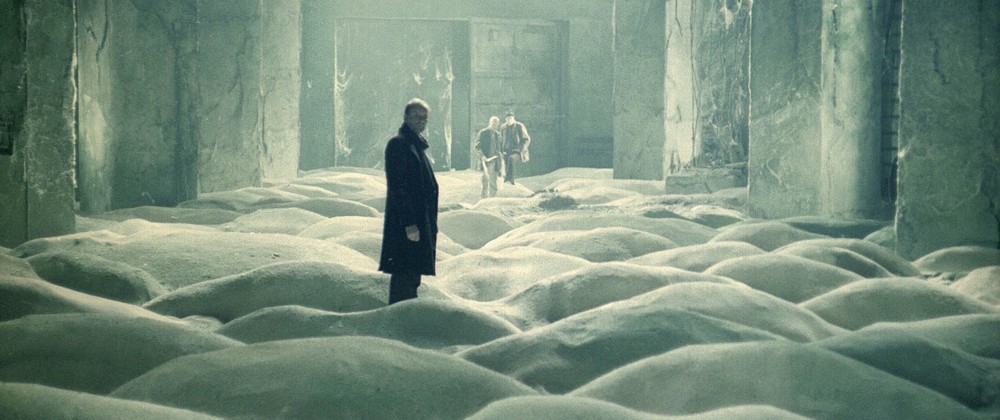 I would not have believed that a short two years since purchasing a DVD player I would own all but one of Andrei Tarkovsky’s films on DVD (the remaining holdout being Ivan’s Childhood). The one Tarkovsky Holy Grail, however, was Stalker, partly because it was never available in any format other than VHS, and it represents a personal favorite. I see Stalker as Tarkovsky’s masterpiece, although according to who you ask there are three other genuine contenders for that honor (Andrei Rublev, Mirror, and Nostalghia). Which is what makes the recent Ruscico (www.ruscico.com) release of Stalker so exciting. Rather than attempt an analysis of the film, something I could not do in less than several thousand soul wrenching words, I’ll provide a synopsis (for those who know nothing of the film) and discuss the enticing morsels of supplementary material featured on the DVD.
Stalker can be best described as a science-fiction film structured as a metaphysical journey – and arguably just that, a meta – rather than physical journey- for three men in search of inner truth and self-worth. Their search takes them from a drab, post-industrial city to a restricted area outside the city limits called the Zone, where it is believed aliens once visited. The Zone is a minefield of perceptual illusions, booby traps, and shifting geography, making each step a potentially life-threatening danger. The Zone has been officially recognized as a forbidden area by the government ever since an investigative group went missing (eerily foreshadowing Chernobyl, where the chemical spill area was also referred to as ‘the Zone’). Legend has it, however, that nestled within the danger-ridden Zone is a room where one’s deep inner wishes are granted. The latter plot point is crucial, because the room sees through superficiality and grants not what you may think you desire, but the desires of your soul. The Stalker (Alexander Kaidanovsky) is someone trained as a guide for people willing to risk their life to reach this wish fulfilling room. His latest ‘clients’ are a Writer (Tarkovsky favorite Anatoly Solonitsyn) and a Scientist (Nikolai Grinko). For these weary travelers, stripped of their self-confidence, faith and ability to love, the room represents, perhaps, their final hope.
I would not have believed that a short two years since purchasing a DVD player I would own all but one of Andrei Tarkovsky’s films on DVD (the remaining holdout being Ivan’s Childhood). The one Tarkovsky Holy Grail, however, was Stalker, partly because it was never available in any format other than VHS, and it represents a personal favorite. I see Stalker as Tarkovsky’s masterpiece, although according to who you ask there are three other genuine contenders for that honor (Andrei Rublev, Mirror, and Nostalghia). Which is what makes the recent Ruscico (www.ruscico.com) release of Stalker so exciting. Rather than attempt an analysis of the film, something I could not do in less than several thousand soul wrenching words, I’ll provide a synopsis (for those who know nothing of the film) and discuss the enticing morsels of supplementary material featured on the DVD.
Stalker can be best described as a science-fiction film structured as a metaphysical journey – and arguably just that, a meta – rather than physical journey- for three men in search of inner truth and self-worth. Their search takes them from a drab, post-industrial city to a restricted area outside the city limits called the Zone, where it is believed aliens once visited. The Zone is a minefield of perceptual illusions, booby traps, and shifting geography, making each step a potentially life-threatening danger. The Zone has been officially recognized as a forbidden area by the government ever since an investigative group went missing (eerily foreshadowing Chernobyl, where the chemical spill area was also referred to as ‘the Zone’). Legend has it, however, that nestled within the danger-ridden Zone is a room where one’s deep inner wishes are granted. The latter plot point is crucial, because the room sees through superficiality and grants not what you may think you desire, but the desires of your soul. The Stalker (Alexander Kaidanovsky) is someone trained as a guide for people willing to risk their life to reach this wish fulfilling room. His latest ‘clients’ are a Writer (Tarkovsky favorite Anatoly Solonitsyn) and a Scientist (Nikolai Grinko). For these weary travelers, stripped of their self-confidence, faith and ability to love, the room represents, perhaps, their final hope.
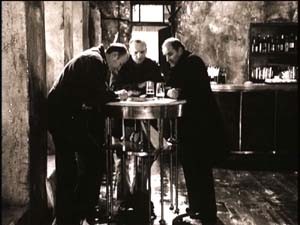 The Three Travelers Meet
After weathering the death traps along their path (rendered through mood and anticipation rather than cinematic, science-fiction pyrotechnics), the men arrive at the threshold of the room (symbolically enough, the gutted remains of a church). We learn that the Scientist, fearing that the wishing room may be misused for evil intention, had planned all along to destroy the room with a bomb he smuggled into the Zone in his knapsack The Stalker makes a frantic plea to let the room exist, as it represents for many the last depository of faith. Shaken and crying, the Stalker is reduced to a pathetic state (what else would you expect from a Tarkovsky ‘hero’?). Somehow the Stalker’s desparate pleas move the Scientist, and he dismantles the bomb. Exhausted, the three men sit quietly outside the room, with neither the energy to continue their philosophical spattings, or the courage to venture into the room and test their inner selves. As if to reflect their sorrowful epiphany, a gorgeous sunshower spontaneously falls into the water-filled room.
The Three Travelers Meet
After weathering the death traps along their path (rendered through mood and anticipation rather than cinematic, science-fiction pyrotechnics), the men arrive at the threshold of the room (symbolically enough, the gutted remains of a church). We learn that the Scientist, fearing that the wishing room may be misused for evil intention, had planned all along to destroy the room with a bomb he smuggled into the Zone in his knapsack The Stalker makes a frantic plea to let the room exist, as it represents for many the last depository of faith. Shaken and crying, the Stalker is reduced to a pathetic state (what else would you expect from a Tarkovsky ‘hero’?). Somehow the Stalker’s desparate pleas move the Scientist, and he dismantles the bomb. Exhausted, the three men sit quietly outside the room, with neither the energy to continue their philosophical spattings, or the courage to venture into the room and test their inner selves. As if to reflect their sorrowful epiphany, a gorgeous sunshower spontaneously falls into the water-filled room.
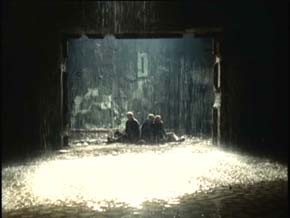 The three men return to their urban wasteland as they left, seemingly bereft of spirit or hope. The three men sit still and quiet in the café where they met at the beginning of the film. In fact, outside of the black dog that identifies the Zone, it could appear as if they never even left the bar. The Stalker’s wife (Alyssa Freindlikh), along with their crippled, mutant daughter ‘Monkey’ (Natasha Abramova), comes to collect her husband at the café. Upon returning to their squalid home, the Stalker burdens his wife with his growing despair in the face of the cynical travellers. If people become so cynical to the point of losing all vestige of hope, what will come of him? The film concludes with the Stalker’s mute daughter performing what appears to be a magical feat of telekinesis by willing a group of glasses to move across the kitchen table.
The three men return to their urban wasteland as they left, seemingly bereft of spirit or hope. The three men sit still and quiet in the café where they met at the beginning of the film. In fact, outside of the black dog that identifies the Zone, it could appear as if they never even left the bar. The Stalker’s wife (Alyssa Freindlikh), along with their crippled, mutant daughter ‘Monkey’ (Natasha Abramova), comes to collect her husband at the café. Upon returning to their squalid home, the Stalker burdens his wife with his growing despair in the face of the cynical travellers. If people become so cynical to the point of losing all vestige of hope, what will come of him? The film concludes with the Stalker’s mute daughter performing what appears to be a magical feat of telekinesis by willing a group of glasses to move across the kitchen table.
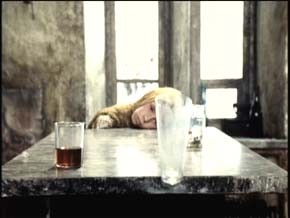 A Metaphor for Faith?
The DVD presents the film in a correctly rendered full-frame aspect ratio (1.33 to 1), with crisp definition and excellent contrast between the film’s complex color/tonal scheme. This is where the DVD gains most from the previous Fox Lorber VHS copy, making the thematically motivated transitions between black and white, monochrome, color (still subdued), and sepia much more striking. The first such transition is from the drab monochrome and black & white of the city to the introduction of color in the Zone, and it is far more demarcated in the DVD than in the VHS copy (as it was in the 35mm print I’ve seen on a few occasions). The three men travel to the Zone by way of a stolen flatcar that they drive along a train track. This visual transition from b/w to color is further underscored aurally by the mesmeric soundtrack during the flatcar journey (clanking of the steel wheels on the tracks, and an oscillating electronic pitch) which places us in a somnolent state (much like the travelers) that makes the change that much sharper to the full sensorial system. Where this DVD is most welcome is in the darkly lit, low-key scenes, namely the scenes in the bar and in the Stalker’s bunker-like apartment, where we can now make out so much more detail of the film’s painstaking production design. The cut from the Writer in the bar (in b/w) to the color shot of the Stalker’s daughter Monkey in color, is even more striking than the initial transition to color when they enter the Zone. Her gold head scarf stands out dramatically, as it should, since the shift to color now assumes important thematic significance – the power, magic, ‘color’ of the Zone – now emerges in the drab cityscape. In fact, in the VHS version the scene in the bar is more sepia than b/w, and to be precise, it is only the daughter who ‘lives’ in color in these post-Zone city scenes, rendering her a specific magical quotient in the film’s philosophical system, which is in keeping with Tarkovsky’s ideas on the purity of children and their ability to intuit reality over and above the culturally/socially conditioned adult. So while the scenes between the whimpering, self-loathing Stalker and his wife are in b/w, the final ‘telekinetic’ scene with the table top glasses, passing train, and daughter is in full color.
A Metaphor for Faith?
The DVD presents the film in a correctly rendered full-frame aspect ratio (1.33 to 1), with crisp definition and excellent contrast between the film’s complex color/tonal scheme. This is where the DVD gains most from the previous Fox Lorber VHS copy, making the thematically motivated transitions between black and white, monochrome, color (still subdued), and sepia much more striking. The first such transition is from the drab monochrome and black & white of the city to the introduction of color in the Zone, and it is far more demarcated in the DVD than in the VHS copy (as it was in the 35mm print I’ve seen on a few occasions). The three men travel to the Zone by way of a stolen flatcar that they drive along a train track. This visual transition from b/w to color is further underscored aurally by the mesmeric soundtrack during the flatcar journey (clanking of the steel wheels on the tracks, and an oscillating electronic pitch) which places us in a somnolent state (much like the travelers) that makes the change that much sharper to the full sensorial system. Where this DVD is most welcome is in the darkly lit, low-key scenes, namely the scenes in the bar and in the Stalker’s bunker-like apartment, where we can now make out so much more detail of the film’s painstaking production design. The cut from the Writer in the bar (in b/w) to the color shot of the Stalker’s daughter Monkey in color, is even more striking than the initial transition to color when they enter the Zone. Her gold head scarf stands out dramatically, as it should, since the shift to color now assumes important thematic significance – the power, magic, ‘color’ of the Zone – now emerges in the drab cityscape. In fact, in the VHS version the scene in the bar is more sepia than b/w, and to be precise, it is only the daughter who ‘lives’ in color in these post-Zone city scenes, rendering her a specific magical quotient in the film’s philosophical system, which is in keeping with Tarkovsky’s ideas on the purity of children and their ability to intuit reality over and above the culturally/socially conditioned adult. So while the scenes between the whimpering, self-loathing Stalker and his wife are in b/w, the final ‘telekinetic’ scene with the table top glasses, passing train, and daughter is in full color.
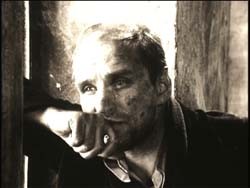
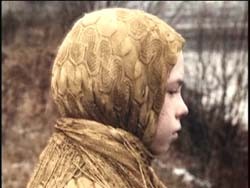 By far the most striking aspect of this DVD is the options in sound selection between the original mono soundtrack and a new Russian 5.1 Dolby. In fact the DVD in my possession is the second printing. Ruscico first released the film with the Russian 5.1 soundtrack, which was not only technologically different from the original, but contained different sound and music elements entirely. I am not sure of the complete story behind these changes, but Ruscico claims that they relied on original sound cues which, it would appear, were not ultimately used by Tarkovsky. As you would expect, fans who received this ‘altered’ version complained about the changes and Ruscico graciously gave their customers the option of exchanging their version for the second pressing. Thankfully, rather than including only the original soundtrack in the second pressing, Ruscico gives us both soundtracks on the follow-up pressing.
The 5.1 version is understandably fuller and more nuanced but, shockingly, contains different sound cues from the original. This is nowhere more striking than in the flatcar scene. What a shock it was to watch this scene, which was etched in my memory with only the sound effects of the wheels and the oscillating pitch, and also hear a Tangerine Dream-like synthesizer melody, choral voices, and other percussive sounds! If we compare the two different soundtracks as they affect the flatcar scene, the 5.1 version is texturally more varied than the original, and interesting in its own right, but is less rhythmically spellbinding and trance-like than the original, and ultimately less effective in rendering the scene’s subjectively extended temporality.
By far the most striking aspect of this DVD is the options in sound selection between the original mono soundtrack and a new Russian 5.1 Dolby. In fact the DVD in my possession is the second printing. Ruscico first released the film with the Russian 5.1 soundtrack, which was not only technologically different from the original, but contained different sound and music elements entirely. I am not sure of the complete story behind these changes, but Ruscico claims that they relied on original sound cues which, it would appear, were not ultimately used by Tarkovsky. As you would expect, fans who received this ‘altered’ version complained about the changes and Ruscico graciously gave their customers the option of exchanging their version for the second pressing. Thankfully, rather than including only the original soundtrack in the second pressing, Ruscico gives us both soundtracks on the follow-up pressing.
The 5.1 version is understandably fuller and more nuanced but, shockingly, contains different sound cues from the original. This is nowhere more striking than in the flatcar scene. What a shock it was to watch this scene, which was etched in my memory with only the sound effects of the wheels and the oscillating pitch, and also hear a Tangerine Dream-like synthesizer melody, choral voices, and other percussive sounds! If we compare the two different soundtracks as they affect the flatcar scene, the 5.1 version is texturally more varied than the original, and interesting in its own right, but is less rhythmically spellbinding and trance-like than the original, and ultimately less effective in rendering the scene’s subjectively extended temporality.
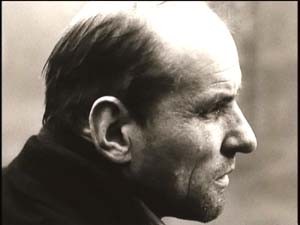 The Mesmeric Trolley Scene
Although the rights for Stalker may one day be picked by a North American company for distribution (as did Criterion for Solaris, another Tarkovsky title released by Ruscico), they will be hardpressed to surpass the curious and fascinating supplementary material on this DVD. The only negative factor is that, like Solaris, the Ruscico film is split across two DVD’s, recalling the bulky laserdisc days. Along with the first part of the film, side 1 contains a five minute clip from The Steamroller and the Violin; about a dozen or so Stalker set photos, the most interesting being one that shows the double track set-up for the flatcar journey; a biography of Andrei Tarkovsky; and a curio entitled "Tarkovsky’s House." "Tarkovsky’s House" is a six minute montage of images of architectural spaces from Tarkovsky’s films, intercut with other architectural images which are similar, but clearly not from any Tarkovsky movies. The non-intertextual images are filmed in a Tarkovskian style, making it hard to distinguish the documentary from Tarkovsky’s fictional world. This is an apt gesture given how closely intertwined the autobiographical was to Tarkovsky’s art. At the end of the short we see the following intertitle, "In this house the great film director Andrei Tarkovsky spent his childhood and adolescence, Zamoskvorechye, 1st Schipkovsky Lane, 1997." The short was directed by Serghei Minenok and shot by cinematographer Victor Dobronitsky.
The Mesmeric Trolley Scene
Although the rights for Stalker may one day be picked by a North American company for distribution (as did Criterion for Solaris, another Tarkovsky title released by Ruscico), they will be hardpressed to surpass the curious and fascinating supplementary material on this DVD. The only negative factor is that, like Solaris, the Ruscico film is split across two DVD’s, recalling the bulky laserdisc days. Along with the first part of the film, side 1 contains a five minute clip from The Steamroller and the Violin; about a dozen or so Stalker set photos, the most interesting being one that shows the double track set-up for the flatcar journey; a biography of Andrei Tarkovsky; and a curio entitled "Tarkovsky’s House." "Tarkovsky’s House" is a six minute montage of images of architectural spaces from Tarkovsky’s films, intercut with other architectural images which are similar, but clearly not from any Tarkovsky movies. The non-intertextual images are filmed in a Tarkovskian style, making it hard to distinguish the documentary from Tarkovsky’s fictional world. This is an apt gesture given how closely intertwined the autobiographical was to Tarkovsky’s art. At the end of the short we see the following intertitle, "In this house the great film director Andrei Tarkovsky spent his childhood and adolescence, Zamoskvorechye, 1st Schipkovsky Lane, 1997." The short was directed by Serghei Minenok and shot by cinematographer Victor Dobronitsky.

The Three Travelers Meet


A Metaphor for Faith?



The Mesmeric Trolley Scene
| Tarkovskian Images from Tarkovsky’s House |
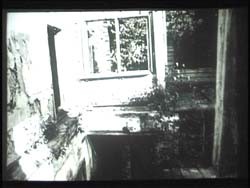
Tarkovskian Images from Tarkovsky’s House
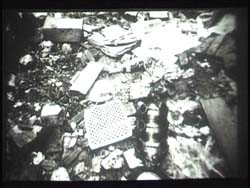
Side two contains the second part of the film, a complete filmography of principal actors and crewmembers, interviews with cinematographer Alexander Knyazhinsky and Production Designer Rashit Safiullin, and two other treats not noted in the supplementary listing, an interview with composer Eduard Artemyev (a highlight of the extras) and a three minute trailer of Solaris (letterboxed). The brief (5’30") interview with Knyazhinsky is the least interesting of the three. This was the last interview he gave, as he died on June 14, 1996, and we sense a self-awareness of this in his depressed state. Far more upbeat and thoughtful are the interviews with Safiullin and Artemyev. Safiullin’s recollections are extremely personal and touching, and we sense a profound love and admiration for Tarkovsky. When asked what the Zone meant to him, he explains that it is a place where people can talk about the most important things, and live out their innermost self, without lies or masks. He then adds, "When Andrei was no more I was bereaved of a person with whom I could talk about the most important things. It was like my "room" vanished." His final, tear-filled words embody the sense of loss he feels over Tarkovsky’s death: "They say you should not pray to an idol. Christ, we have run out of idols."
Nestled in the Artemyev filmography is a link to the Solaris trailer and a 21’00" interview with Artemyev, who composed the music for Solaris, Mirror, and Stalker. The interview is a fascinating discussion of the complex working relationship he had with Tarkovsky who, unlike Safiullin, he admits to not knowing intimately. In keeping with the subject, the director of this interview cleverly introduces snippets of Artemyev’s musical work for Tarkovsky, at times as it appears in the films and other times adulterated. Also intercut into the interview are never before seen b/w stock footage of a young Tarkovsky, including one striking slow motion shot of a dapper, handsome Tarkovsky walking along a busy Moscow sidewalk, with the finale music of Mirror swelling on the soundtrack.
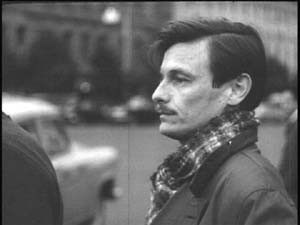
Don’t miss out on these ‘hidden’ features of the DVD. In keeping with the Ruscico tradition, this DVD is a linguist’s delight: subtitles are available in no less than 11 languages (English, French, Spanish, Italian, Dutch, Japanese, Swedish, Portuguese, Hebrew, Arabic, and Chinese)!

Nenhum comentário:
Postar um comentário